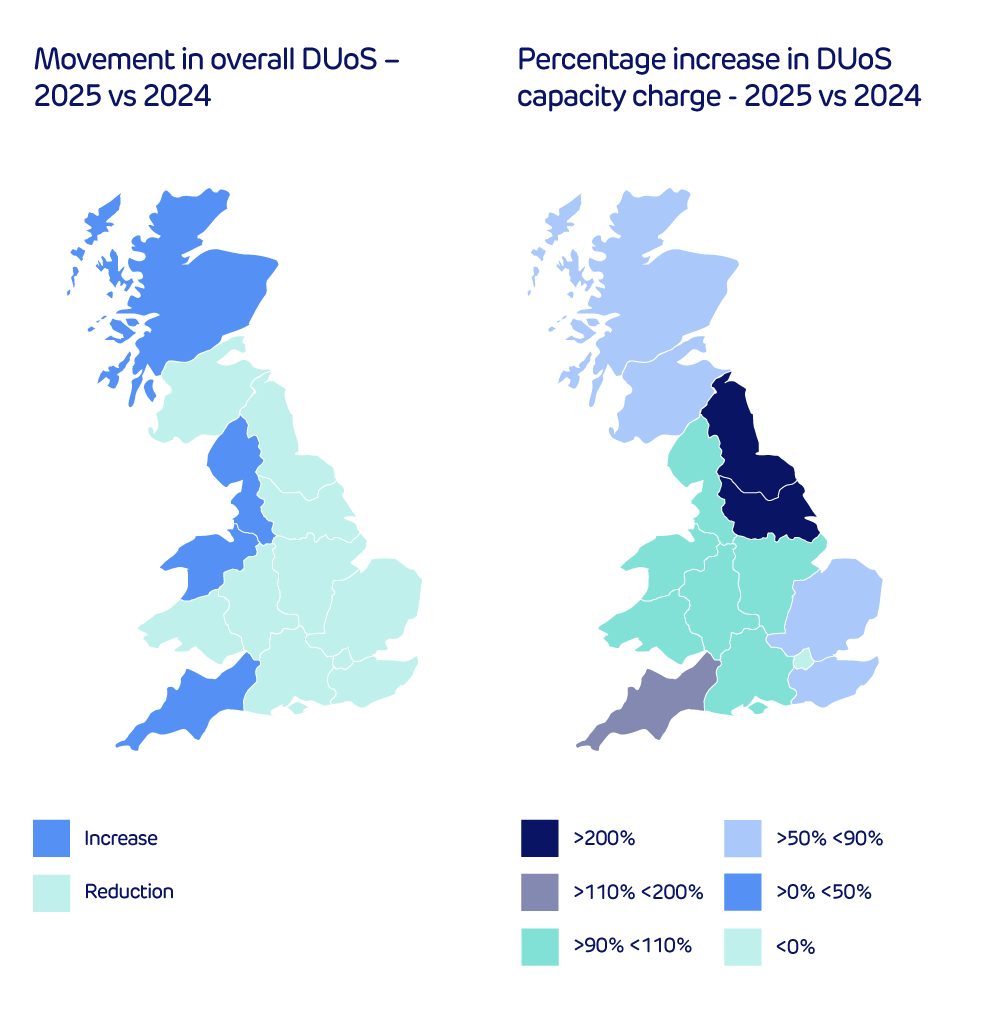DUoS charges: 2025’s box of frogs
It’s all change in Distribution Use of System (DUoS) costs, one of the largest components of every power bill. Distribution Network Operators (DNOs) have published rates for 2025 revealing a marked increase in capacity charges and fall in fixed costs.

Published just before Christmas, the final DUoS charges for 2025-26 in most regions show a significant variance to those being levied in 2024-25. This is due to an approximate doubling of capacity charges, which means it’s important for organisations to ensure they don’t set their Maximum Import Capacities (MICs) at too high a level. Simultaneously, DNO’s standing charges are being slashed across most regions, leading to a slight drop in overall DUoS for many users.
If we take a residual band 2 low voltage-connected site-specific user*, compared to 2024-25:
- Overall DUoS costs will fall year-on-year by an average of 6%, ranging from a 25% increase in the region operated by Electricity North West Limited to a 32% drop in Northern Powergrid (Northeast) Limited.
- The standing charges (fixed pence per day charge) will drop an average of 72%, ranging from a 100% reduction to charges levied by Southern Electric Power Distribution to a 17% increase in charges levied by London Power Networks plc.
- Capacity charges will double on average (+108%), but more than triple in the region owned by Northern Powergrid (Northeast) Limited (+246%).
- Unit rates will increase 30%-40% on average across the majority of regions, although drops will occur in charges levied by London Power Networks plc and Southern Electric Power Distribution. DUoS unit rates to be charged by Eastern Power Distribution plc will experience mixed movements.
Note: the actual change in costs experienced will depend on the load profile and MIC of each site.

Source: DNO 2025 charging statements, Low Voltage Site-Specific customer
Why are DUoS charges rising?
DNOs must provide 15 months’ notice of their DUoS charges.
A range of factors will influence DUoS in 2025-26, including:
- The implementation of Ofgem’s Access Significant Code Review (SCR) final decision
- Assumptions about changing usage of the distribution networks and changes in input items in the charging model
- Changes in allowed revenues
DNOs use the methodology outlined in the Distribution Connection and Use of System Agreement (DCUSA) and industry models to establish how they’ll apportion network charges to different users on the system. They charge the vast majority of sites on a generic “user” basis under the Common Distribution Charging Model (CDCM). They allocate only the very largest consumers (those connected above 22kV) with unique tariffs. The models assume certain characteristics about a site’s behaviour, features and costs to generate forward-looking charges.
Totalling the expected forward-looking payments from all the sites that a DNO’s responsible for provides it with an annual expected revenue. However, this may be very different to the allowed revenues that it can make for the year, resulting in a top-up (or a reduction). This alteration is known as the “residual” and, since Ofgem implemented the Targeted Charging Review (TCR), it applies only to standing charges.
The change in 2025 comes from the implementation, for the first time, of Ofgem’s Access SCR into charges. This happened because the regulator sees up-front distribution connection fees as a potential barrier to the deployment of low-carbon technologies such as heat pumps and EV chargers. The Access SCR reduces the costs that a user requesting a new-demand connection needs to pay up-front. However, contributions that customers make towards their connection are included in the network charging model to adjust their ongoing use of system charges. Removing the contributions in the model has the potential to increase forward-looking elements of the DUoS charge (unit rates and capacity charges).
Fixed standing charges have typically reduced quite dramatically for two reasons:
- Increases in forward-looking charges mean the residual needs less topping up
- Allowed revenues for the majority of DNOs have fallen from the highs of 2024. This is due to the 2024-25 charging model using a very high inflationary environment and assumptions. Therefore, the 2025 charges represent a slight “normalisation” of costs, following a period of much higher DUoS charges in 2024. However, there’ll be much higher capacity charges and unit rates, and lower fixed charges, than in 2023 or 2024.
The overall impact on businesses will be very varied. Previously, users were most concerned about residual bandings and their influence on the standing charges they would pay. This general drop in standing charges means that MIC and unit rates are more important determinants of overall DUoS in 2025.
Charges for customers connected at Extra High Voltage (EHV, over 11kV) have also experienced high volatility. In some regions, these customers have been shielded from this by temporarily suspending the charging methodology. Ofgem is looking to reduce EHV charging volatility through its separate DUoS SCR workstream.
*User determined using East Midlands Annual Review Pack, assuming average Low Voltage Site-Specific Residual Band 2, average consumption under each band, and import capacity for 2025-26.
Disclaimer
We’ve used all reasonable efforts to ensure that the content in this article is accurate, current, and complete at the date of publication. However, we make no express or implied representations or warranties regarding its accuracy, currency or completeness. We cannot accept any responsibility (to the extent permitted by law) for any loss arising directly or indirectly from the use of any content in this article, or any action taken in relying upon it.

